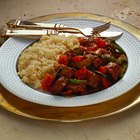
While flour tortillas are traditionally made with lard or shortening, you can make them with vegetable oil. A slight alteration to your recipe is all that is needed. Fresh homemade tortillas are soft and chewy, unlike supermarket tortillas. Once you've tried them, you'll want to make them often. If time is short, make the dough ahead and store it covered in the refrigerator overnight.
Making Tortillas with Vegetable Oil
You can easily adapt a tortilla recipe to use oil instead of shortening. Simply mix the dry ingredients thoroughly, then add the oil with approximately 3/4 of the water called for in the recipe. Mix with a fork, adding small amounts of additional water as needed to bring the dough together. If the dough is too moist and sticky, knead in a little flour. Shape, rest and cook the dough as your recipe directs.
Related Articles

How to Make Rice Flour Tortillas

How to Freeze Stromboli

How to Cook Tender Rolled Flank Steaks ...

How to Bake Boneless Skinless Tilapia

How to Cook Luglug Cornstarch Noodles
How to Slow Cook a Pot Roast With Beef ...

Can You Bake Sliders?

How to Cook Steel-Cut Oats in a Slow ...

How to Cook Couscous With Chicken Broth

How to Cook Tapioca Flour to Make Bread

Good Marinade for a Chicken & Steak ...
How to Cook Atlantic Cod Fillets

How to Cook Tortillas in the Oven

How to Cook Moose Meat

How to Make a White Decorator Icing

How to Cook a Frozen Beef Patty ...

How to Make a Juicy Pork Tenderloin

How Many Calories are in Cheese Lasagna?

How to Make Toasted Bread Sticks With ...

How Long Does It Take to Cook Linguine?
References
Writer Bio
Diane Watkins has been writing since 1984, with experience in newspaper, newsletter and Web content. She writes two electronic newsletters and has a Bachelor of Science degree in chemistry from Clemson University. She has taken graduate courses in biochemistry and education.
Photo Credits
Jupiterimages/Photos.com/Getty Images